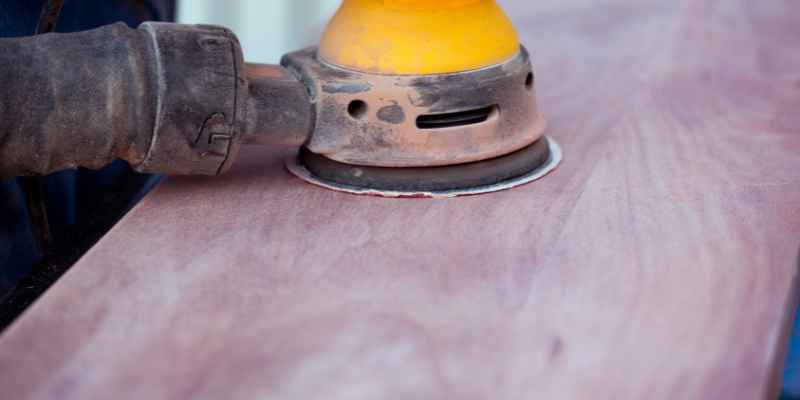Yes, you can sand treated wood safely. Sanding treated wood is a common practice to prepare the surface for staining or painting.
It helps to smooth out rough patches and enhance the overall appearance of the wood. However, it is essential to follow safety precautions when sanding treated wood, such as wearing proper protective gear and working in a well-ventilated area to avoid inhaling harmful dust particles.
Additionally, choosing the right sandpaper grit and sanding technique is crucial to achieve desired results without damaging the treated wood surface. By following these guidelines, you can effectively sand treated wood and achieve a professional finish for your woodworking projects.
Safest Methods For Sanding Treated Wood
Sanding treated wood can be done safely by following certain precautions. Avoid sanding in confined spaces and work outdoors whenever possible. Clean up sawdust and avoid using treated wood where it can come into contact with food or water supplies.
Choosing The Right Sanding Tools
When sanding treated wood, choosing the right sanding tools is crucial. Ensure that you use a belt sander or orbital sander with appropriate grit sandpaper. Coarse grits are useful for initial sanding, followed by fine grits for a smooth finish.
Ensuring Safety Measures During Sanding
To ensure safety during sanding, it is important to take the necessary precautions. Always wear a mask, goggles, and gloves to protect yourself from inhaling sawdust and potential harmful chemicals. Work in a well-ventilated area to prevent the buildup of harmful particles. Avoid sanding treated wood indoors to minimize exposure to potentially harmful chemicals.
Effectiveness Of Sanding Treated Wood
Sanding treated wood can be effective in certain situations, but caution should be exercised. Sanding can remove the chemical coating and alter the appearance of the wood. It is recommended to use a stain formulated for pressure-treated wood to achieve the desired look.
Impact On The Appearance Of The Wood
Sanding treated wood can greatly enhance the overall appearance of the wood surface.
Enhancing The Absorption Of Stains
Effective sanding ensures that stains are absorbed more evenly and deeply into the wood.
Can Sanding Remove The Treatment?
When sanding treated wood, be cautious as it may not fully remove the treatment. Sanding can alter the appearance, and it’s safer to simply stain the wood as is for optimal results. Avoid sanding pressure-treated wood excessively to maintain its integrity.
Understanding The Limitations Of Sanding
When it comes to maintaining and enhancing the appearance of treated wood, sanding is a popular option. But can sanding remove the treatment? It’s important to understand the limitations of sanding before diving into this task.
Sanding can indeed help restore the smoothness and appearance of treated wood, but it won’t remove the treatment entirely. The treatment chemicals penetrate deep into the wood fibers, ensuring protection against rot, decay, and insects. So, even if you sand the surface, the treatment will remain in the wood.
But why can’t the treatment be completely removed?
The treatment chemicals are designed to be long-lasting and effective. Attempting to completely remove the treatment through sanding would require removing a significant amount of wood, potentially compromising the structural integrity of the piece.
So, what can you expect when sanding treated wood?
When you sand treated wood, you can expect to remove surface imperfections, such as scratches, stains, and roughness. Sanding can help restore the appearance of the wood by creating a smoother surface, making it easier to apply finishes, paints, or stains.
Keep in mind that sanding treated wood can be a dusty process, so wearing personal protective equipment, such as goggles and a mask, is essential. Additionally, it’s crucial to work in a well-ventilated area to minimize exposure to any residual treatment chemicals.
Advice On Maintaining Treated Wood
Now that you understand the limitations of sanding treated wood, it’s important to focus on maintaining it properly to extend its lifespan and preserve its appearance. Here are some tips:
- Regular cleaning: Dirt, debris, and mold can deteriorate the appearance of treated wood over time. Regularly clean the surface with a mild soap and water solution to remove these pollutants.
- Apply protective finishes: A high-quality finish, such as a sealant or stain specifically formulated for treated wood, can provide an additional layer of protection against weathering and UV damage.
- Inspect for damage: Routinely inspect the wood for any signs of rot, decay, or insect infestation. Promptly address these issues to prevent further damage.
- Avoid direct contact with water: While treated wood is resistant to decay, it’s best to avoid direct and prolonged contact with water. Use barriers, such as waterproof coatings or elevated platforms, to protect the wood from moisture when possible.
By following these maintenance tips, you can ensure that your treated wood stays in great condition and continues to enhance the aesthetic appeal of your outdoor spaces.
Best Practices For Staining Treated Wood
When it comes to staining treated wood, it’s important to follow best practices to achieve a beautiful and long-lasting finish. From choosing suitable stains to preparing the wood surface, these steps will ensure your project is a success. Let’s dive into the details:
Choosing Suitable Stains For Treated Wood
Not all stains are suitable for treated wood, so it’s crucial to choose the right one for optimal results. When selecting a stain, consider the wood’s natural grain and color as well as the desired outcome. Additionally, opt for stains specifically formulated for use with pressure-treated wood, as they are designed to penetrate and protect the wood effectively.
Preparing The Wood Surface For Staining
Properly preparing the wood surface is essential to ensure the stain adheres correctly and provides a smooth finish. Here are some steps to follow:
- Start by cleaning the wood thoroughly to remove any dirt, debris, or previous coatings. Use a mild detergent and water, and scrub the surface gently with a brush or sponge. Rinse the wood with clean water and allow it to dry completely.
- Next, inspect the wood for any rough or damaged areas that may need to be sanded. Use a sandpaper with a fine grit to smooth out any imperfections, ensuring a uniform surface for the stain to adhere.
- If the wood has been previously stained or painted, it may be necessary to strip the old finish before proceeding with staining. Follow the manufacturer’s instructions for the appropriate stripping product and method to use.
- Once the wood surface is clean, smooth, and free from any old coatings, it is ready for staining. Tape off any areas that should not be stained, such as hardware or neighboring surfaces, to ensure clean lines and avoid accidental staining where it’s not wanted.
- Before applying the stain, mix it thoroughly according to the manufacturer’s instructions. This ensures an even distribution of color pigments and maximizes the stain’s effectiveness.
By following these best practices, you can ensure that your stained treated wood project will turn out beautifully and withstand the test of time. Remember to work in a well-ventilated area and wear appropriate protective gear, such as gloves and goggles, during the staining process.
Expert Opinions On Sanding Treated Wood
Sanding treated wood is a common practice, but it’s essential to follow safety measures. Avoid sanding treated wood indoors and ensure proper ventilation when working outdoors. Additionally, clean any sawdust to maintain a safe and healthy workspace. Following these precautions is crucial to stay safe while sanding treated wood.
Insights From Professionals In The Industry
Professionals suggest avoiding sanding treated wood to maintain its appearance and integrity.
Common Misconceptions About Sanding Pressure-treated Wood
- Sanding won’t remove the treatment entirely.
- Avoid sanding treated wood in confined spaces.
- Use outdoor spaces to minimize health risks.
Addressing Common Questions
Staining Timelines For Pressure-treated Wood
For pressure-treated wood, it’s recommended to wait for the wood to adequately dry before staining. This typically takes a few months.
Managing Expectations For The Appearance Of Treated Wood
Pressure-treated wood may not have a uniform appearance after staining, as it can absorb stain unevenly due to its treatment.

Frequently Asked Questions On Can You Sand Treated Wood
Is Sanding Treated Wood Safe?
Yes, sanding treated wood is safe if done outdoors and with proper protection to avoid inhalation. It’s important to clean sawdust and work in well-ventilated areas. Sanding removes the chemical coating, altering the appearance, so it’s best to use a stain formulated for pressure-treated wood.
Does Sanding Treated Wood Remove The Treatment?
Sanding treated wood does not remove the treatment but enhances staining adhesion for a smoother finish.
What Should Never Be Done With Pressure-treated Wood?
Sanding treated wood is not recommended due to the chemicals used in its treatment. Avoid sawing or sanding in confined spaces. Work outdoors whenever possible and clean sawdust from personal protective equipment and your workspace thoroughly. Refrain from using treated wood in contact with drinking water supplies, food, or beehives.
Instead, consider using a stain formulated for use with pressure-treated wood to enhance its appearance.
How Do You Make Pressure-treated Wood Look Good?
To make pressure-treated wood look good, use a stain designed for pressure-treated wood. Consider using a semi-transparent deck stain that allows the wood’s natural grain to show through. Lightly sand the wood before applying the stain to improve adhesion and create a smooth surface.
Avoid sanding too much, as it can affect the wood’s appearance.
Conclusion
Sanding treated wood is doable but requires caution. Avoid sanding indoors & clean thoroughly to prevent health hazards. Once sanded, treated wood won’t look new again, so use staining for a refreshed appearance. Follow safety guidelines for handling and staining pressure-treated wood.


